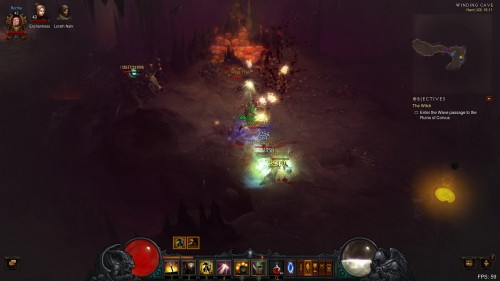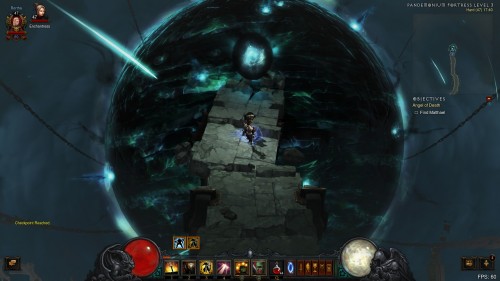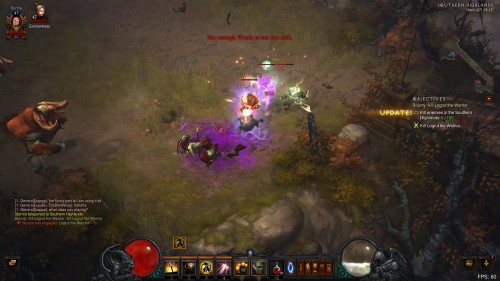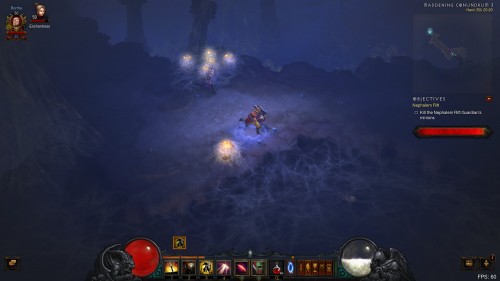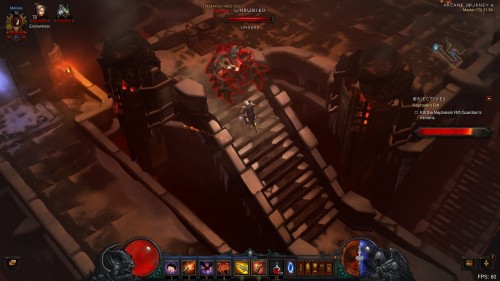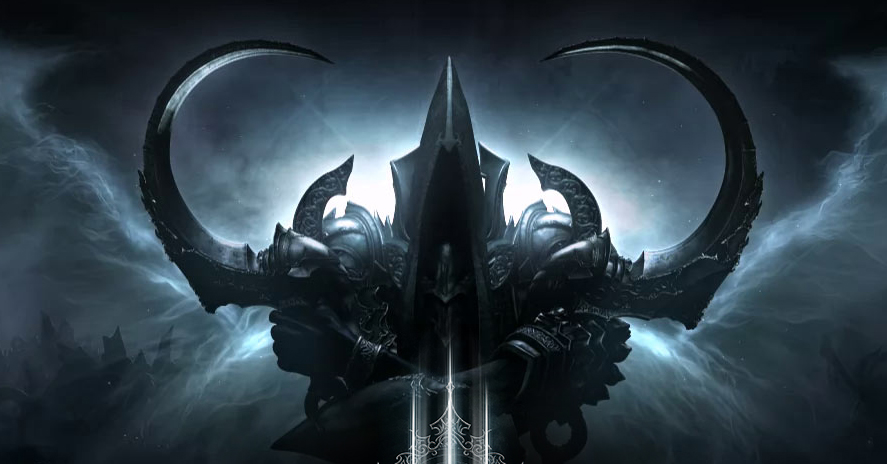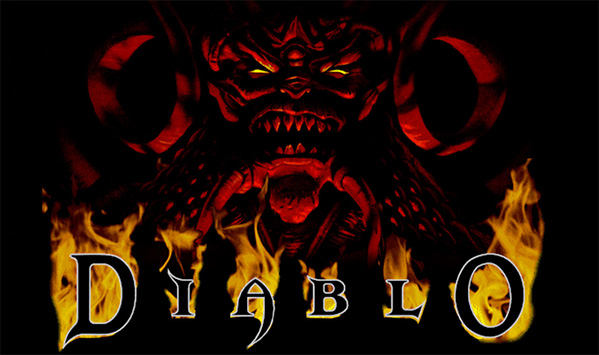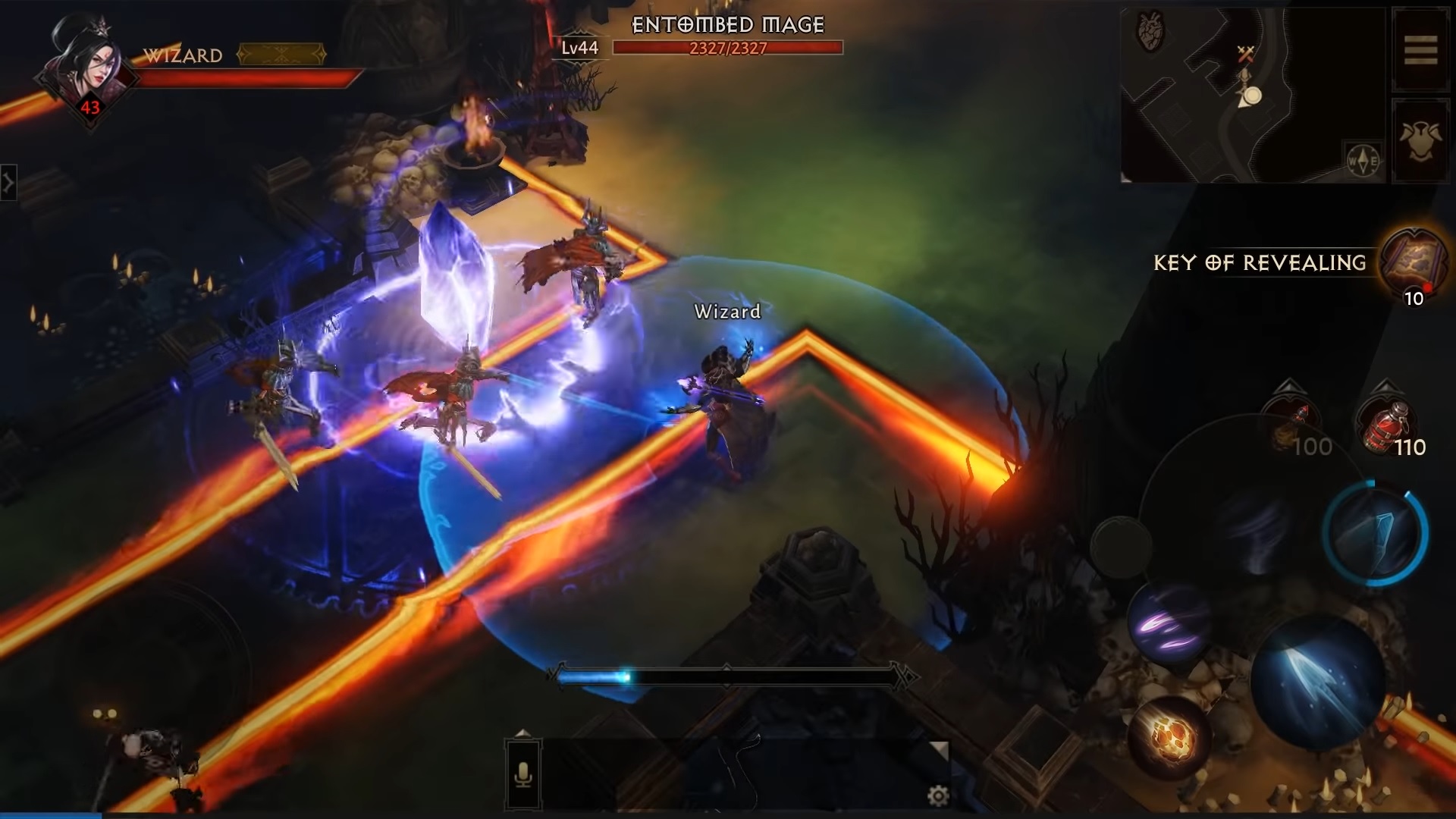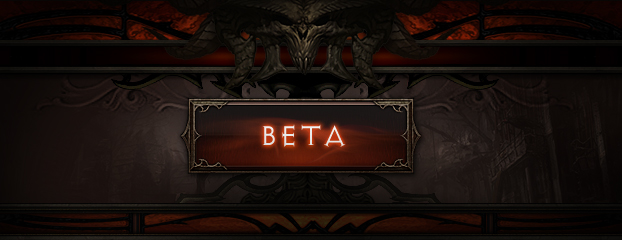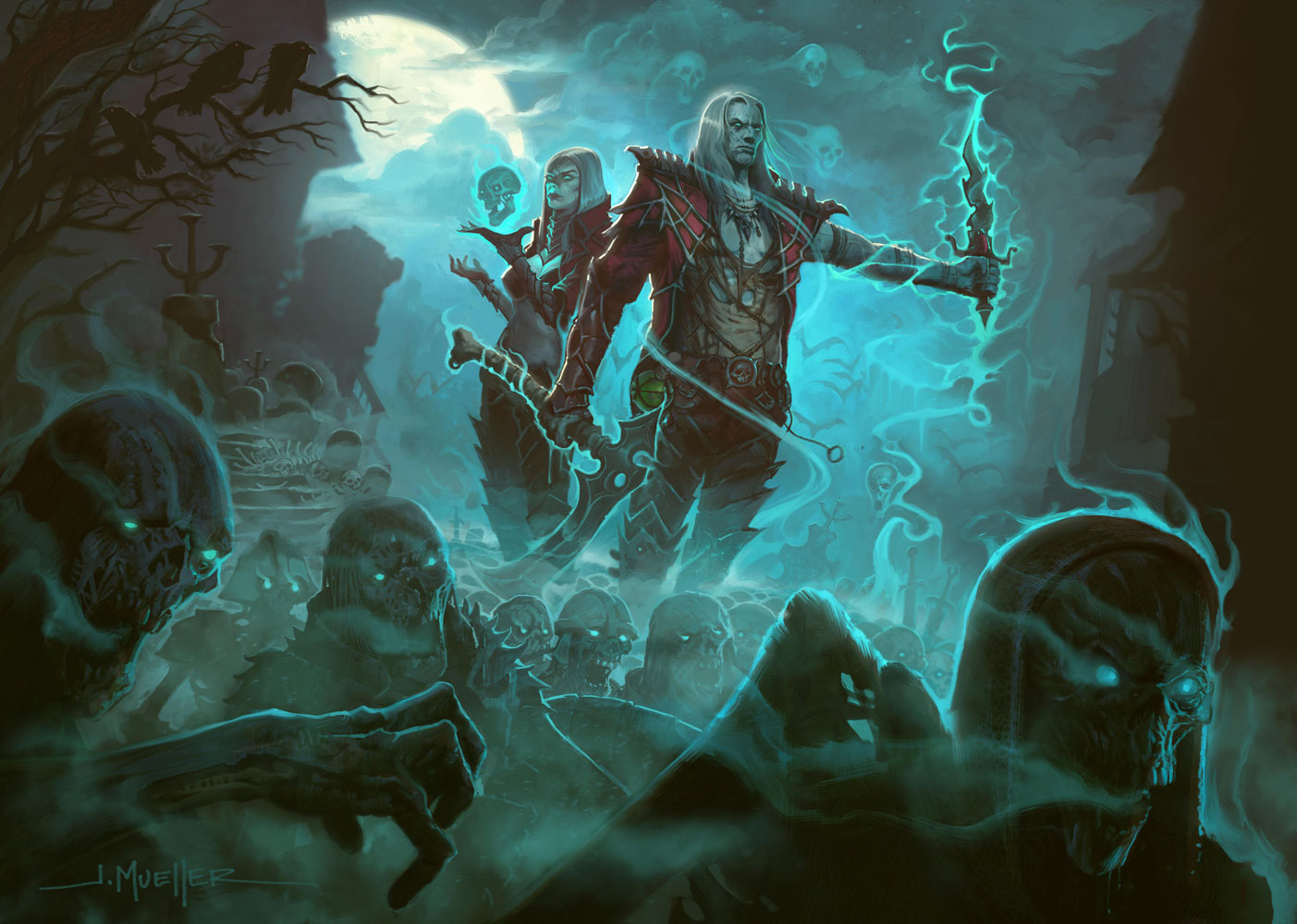
So, Diablo III, we meet again. It’s been two years since the game first launched amid a torrent of anger at its always-online requirements and then over a loot system that forced players to use the Auction House to get the best gear. Internal changes, such as the departure of development lead Jay Wilson, have brought about new philosophies for the game. We first saw these in last year’s console release, which updated the loot system and made a number of other mechanical changes to bring about what I said at the time was the definitive Diablo III experience.
So now, we come to Diablo III: Reaper of Souls, the first expansion to the game, and a dramatic overhaul of the experience. The auction house is gone, there’s an entirely new loot system in place, crafting is dramatically streamlined and the game is, overall, quite different to the one that launched in 2012.
Before we get to the expansion, though, it’s worth looking at the aspects of the game that are new, but which are part of the 2.0.3 content patch. These are features that everyone gets, regardless of whether or not they purchased Reaper of Souls.
Loot 2.0, as it’s come to be called, is perhaps the most dramatic change to Diablo III since it launched. The decision to close down the controversial auction house has freed Blizzard up to ensure that when you’re out killing demons, the loot they drop is actually loot you can use. The system is a further development from the one on the console version last year. The main difference is “smart loot”, which is loot that drops specifically for your class, and which makes up the majority of loot you’ll find as you play. This means that upgrades are much easier to find, even as you hit the level cap and start farming monsters. There’s fewer trash items, most of which convert to gold now instead of lying around, never to be picked up.
The new loot means that characters are much better equipped to take on the game’s monsters, and the lower difficulty levels will feel like a cakewalk for even a moderately skilled player. Fortunately, the second big change for Diablo III is the new difficulty levels. The old Normal/Nightmare/Hell/Inferno progression is gone. Instead, monsters level with your character until the level cap. Difficulty is now selectable right off the bat, with only the Torment difficulty being locked away until you reach level 60.
The new difficulty levels are Normal, Hard, Expert, Master and Torment. Normal is the baseline experience, and provides very little challenge for most players. The higher difficulties bring better rewards: XP and gold drops are increased, and you’re more likely to find better items as well. The hardest difficulty, Torment, has six difficulty settings of its own, similar to the Monster Power setting that it effectively replaces. This is intended to be the true endgame for Diablo III now, and offers up a set of exclusive legendary items that can’t be found elsewhere.
The Paragon system has been completely overhauled. Previously, paragon levels provided stat advancement beyond level 60, and felt mostly like a hastily-added feature to enhance what was, at the time, a weak endgame. In the new system, there’s no cap to paragon levels, and they’re account-wide. Every character you play will contribute to your paragon experience once they hit level 70 (or 60 if you don’t buy the expansion). Each paragon level gives you a paragon point that you can spend in one of sixteen stats divided across four categories. The categories are cycled, so you get one point for each category every four levels. There’s no longer a maximum limit to Paragon levels, either, although the experience required for each one increases dramatically as you level.
A lot of streamlining has been done to areas like looting, crafting and even health potions, which have been reduced to a single potion that heals a flat 60% of total health, like the console version. Crafting is now streamlined, with all pre-RoS gear crafted through the same set of materials, while RoS gear has a different set of materials that drops once you hit level 61. There’s no longer any need to identify rare (yellow) items, meaning the traditional “identify all the things” dance is no longer required once you head back to town. Even the pause screen got a significant overhaul.
Clans and communities are another new feature of the 2.0 patch. Clans are basically like their Starcraft II equivalents, similar to, but not exactly like, guilds in World of Warcraft. There’s also communities, which, unlike clans, allow an unlimited number of members and don’t necessarily require an invite to join.
Finally, Nephalem Glory has made it over from the console version. These are golden orbs that occasionally drop instead of health orbs, and which give you a stacking buff that increases movement speed and causes additional damage when you attack. It’s a nice bonus, and one that plays heavily into the new Crusader class.
With all these changes to the base game, you might be wondering what you get for your money when you buy Reaper of Souls. Well, don’t worry, because Blizzard have, smartly, reserved the really good stuff for the expansion itself.
First up, there’s ten new levels to earn. These activate the instant the expansion is added to your Battle.net account, so you won’t be able to earn Paragon levels again until you hit level 70. From level 61 onwards, new loot will drop, as will new crafting materials. The levels themselves will come very quickly for most players, especially if you’re playing on the higher difficulties. Don’t be afraid to drop down a difficulty or two, either, due to the fact that your gear is unlikely to keep up with the increasingly powerful monsters until you reach level 70.
The most obvious addition in Reaper of Souls is, of course, an entire new fifth act. It may seem odd to be this far into the review and not yet have even mentioned the actual expansion content, but the truth is that Act V really isn’t all that important overall. Yes, it’s story progression, and the new tale of the angel Malthael and his plan to end the Eternal Conflict between angels and demons forever is a fun one, but it just seems to be a small part of the overall experience.
The new locations look fantastic. Westmarch is suitably gothic, with tall buildings and lots of stone arches and cobbled pathways. The other areas include yet another marshy boggy area (filled, amusingly, with monsters called ‘bogans’), and Pandemonium itself, the battleground upon which the Eternal Conflict takes place. Pandemonium is the most visually interesting area, especially its final stages. Blizzard’s artists have really outdone themselves with the final stages of the act, living up to the very high standards they set for themselves.
The new act does bring some interesting new storyline aspects that Diablo III previously shied away from. The three companions you can travel with all now have sidequests that help flesh out their backstory better. There’s also a small number of storyline moments that play out differently based on your class, and not in the “insert class dialogue into otherwise normal conversation” way, either.
The reason I say that Act V is perhaps not as important to Reaper of Souls as it should be is because of the other big feature the expansion brings: Adventure mode. This mode lets you play through the acts without having to deal with the story. Instead, you jump around the act collecting bounties. Collect five of these and you’re rewarded with a Horadric Cache, a bag of high-quality loot. You’re also rewarded with blood shards, which can be turned in at a new mystery items vendor for a chance at rare loot.
As you go about collecting bounties, you’ll pick up rift key fragments. Five of these allow you to unlock Nephalem Rifts. These are entirely randomly-generated dungeons filled with monsters that you can fight your way through. That’s right: infinite random dungeons have finally made their way to Diablo III. Rifts are completed by killing enough monsters to fill up a meter at the side of the screen, and then killing a powerful boss monster. The idea here is that you can always just open up a rift (assuming you have fragments) for a quick, unique 20-ish minute dungeon crawl that provides good loot and experience. The rifts use the existing map segments, but in new, random ways. They may not fully replace farming runs, but for some players they’ll definitely help relieve the boredom of running the same part of an act over and over again.
The final big addition of Reaper of Souls is the new Crusader class. Designed as a shield-bearing tank class, the Crusader deals damage primarily with holy abilities and powerful melee and ranged attacks. I can’t help but feel that the Crusader is the most underwhelming aspect of the expansion, with noticeably lower damage output than the other classes, and few interesting choices in terms of class builds. Its highly likely that the class will receive lots of balance changes and buffs as Blizzard responds to player feedback and internal analysis of the class. Crusaders have been ‘inserted’ into the original Diablo III story, although they thematically fit in with the new Act V content. Overall, I’m not yet sold on the class, but I’m not giving up on it, either.
A lot of developers, when faced with the mostly hostile feedback Blizzard received in the months after Diablo III’s launch, would have simply given up and promised a better effort in the sequel. They would have gone out and made an entirely new game and charged everyone for it, hoping they’d be forgiven for their past mistakes. Blizzard have not done this. There’s a core belief within the studio that Diablo III is the game they wanted to make, but that they made some poor choices that they want to correct. In that sense, Reaper of Souls is atonement. Sure, they’re charging for it, but not as a full-price game, and much of the important mechanical changes are being given to everyone anyway.
From the beginning, I’ve loved Diablo III, despite its flaws. As the situation with the loot and the auction house became clearer, it got harder and harder to enjoy, and I ended up mostly abandoning the PC version in favour of the PS3 version last year. With the launch of Reaper of Souls, I’m fully back on board. This feels much more like the game Blizzard promised all those years ago. Meaningful loot, coupled with the new adventure mode and much friendlier crafting makes every play session feel worthwhile. Nephalem Rifts are, for me, the biggest new feature, providing a new and unique piece of content each time, as often as I want.
If you liked Diablo III already, then Reaper of Souls is a no-brainer. Just get it and enjoy. If you quit in disgust, then it might be a harder sell. It all depends on what you wanted out of Diablo III in the first place. Diehard Diablo II players will likely never be properly satisfied (and they’ve probably all moved on to Path of Exile by now anyway), and it’s unlikely that Blizzard could do anything to win them over at this stage.
But if, like me, you just happen to really enjoy clicking on things until they explode in showers of glorious loot, then Diablo III: Reaper of Souls is the best choice on the market right now.
The game we wished for is finally here
Adventure mode and Nephalem rifts are amazing
Act V
It took two years and we have to buy what should have been fixed in the first place.
Crusader class is a little underwhelming right now.

